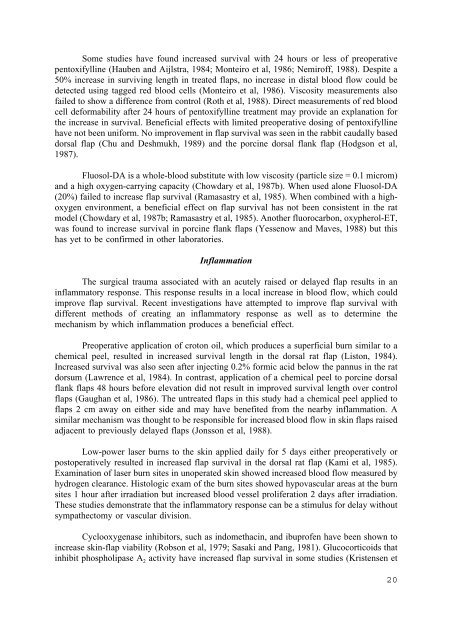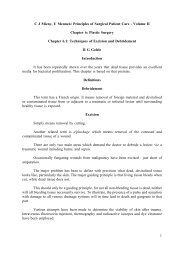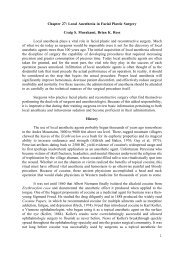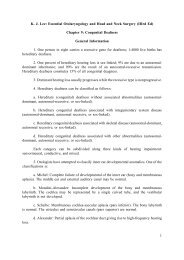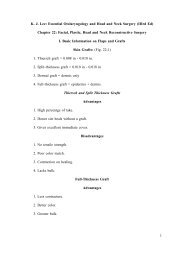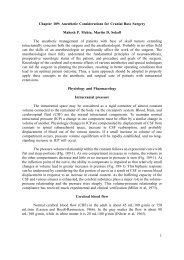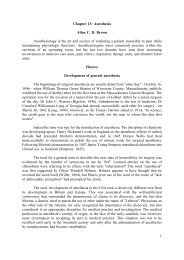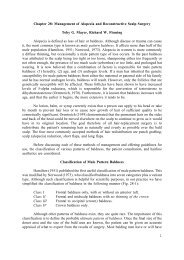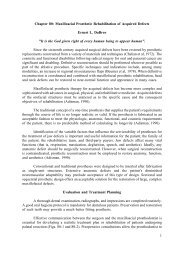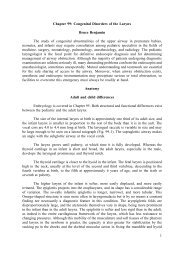1 Chapter 8: Skin Flap Physiology George S. Goding ... - Famona Site
1 Chapter 8: Skin Flap Physiology George S. Goding ... - Famona Site
1 Chapter 8: Skin Flap Physiology George S. Goding ... - Famona Site
Create successful ePaper yourself
Turn your PDF publications into a flip-book with our unique Google optimized e-Paper software.
Some studies have found increased survival with 24 hours or less of preoperative<br />
pentoxifylline (Hauben and Aijlstra, 1984; Monteiro et al, 1986; Nemiroff, 1988). Despite a<br />
50% increase in surviving length in treated flaps, no increase in distal blood flow could be<br />
detected using tagged red blood cells (Monteiro et al, 1986). Viscosity measurements also<br />
failed to show a difference from control (Roth et al, 1988). Direct measurements of red blood<br />
cell deformability after 24 hours of pentoxifylline treatment may provide an explanation for<br />
the increase in survival. Beneficial effects with limited preoperative dosing of pentoxifylline<br />
have not been uniform. No improvement in flap survival was seen in the rabbit caudally based<br />
dorsal flap (Chu and Deshmukh, 1989) and the porcine dorsal flank flap (Hodgson et al,<br />
1987).<br />
Fluosol-DA is a whole-blood substitute with low viscosity (particle size = 0.1 microm)<br />
and a high oxygen-carrying capacity (Chowdary et al, 1987b). When used alone Fluosol-DA<br />
(20%) failed to increase flap survival (Ramasastry et al, 1985). When combined with a highoxygen<br />
environment, a beneficial effect on flap survival has not been consistent in the rat<br />
model (Chowdary et al, 1987b; Ramasastry et al, 1985). Another fluorocarbon, oxypherol-ET,<br />
was found to increase survival in porcine flank flaps (Yessenow and Maves, 1988) but this<br />
has yet to be confirmed in other laboratories.<br />
Inflammation<br />
The surgical trauma associated with an acutely raised or delayed flap results in an<br />
inflammatory response. This response results in a local increase in blood flow, which could<br />
improve flap survival. Recent investigations have attempted to improve flap survival with<br />
different methods of creating an inflammatory response as well as to determine the<br />
mechanism by which inflammation produces a beneficial effect.<br />
Preoperative application of croton oil, which produces a superficial burn similar to a<br />
chemical peel, resulted in increased survival length in the dorsal rat flap (Liston, 1984).<br />
Increased survival was also seen after injecting 0.2% formic acid below the pannus in the rat<br />
dorsum (Lawrence et al, 1984). In contrast, application of a chemical peel to porcine dorsal<br />
flank flaps 48 hours before elevation did not result in improved survival length over control<br />
flaps (Gaughan et al, 1986). The untreated flaps in this study had a chemical peel applied to<br />
flaps 2 cm away on either side and may have benefited from the nearby inflammation. A<br />
similar mechanism was thought to be responsible for increased blood flow in skin flaps raised<br />
adjacent to previously delayed flaps (Jonsson et al, 1988).<br />
Low-power laser burns to the skin applied daily for 5 days either preoperatively or<br />
postoperatively resulted in increased flap survival in the dorsal rat flap (Kami et al, 1985).<br />
Examination of laser burn sites in unoperated skin showed increased blood flow measured by<br />
hydrogen clearance. Histologic exam of the burn sites showed hypovascular areas at the burn<br />
sites 1 hour after irradiation but increased blood vessel proliferation 2 days after irradiation.<br />
These studies demonstrate that the inflammatory response can be a stimulus for delay without<br />
sympathectomy or vascular division.<br />
Cyclooxygenase inhibitors, such as indomethacin, and ibuprofen have been shown to<br />
increase skin-flap viability (Robson et al, 1979; Sasaki and Pang, 1981). Glucocorticoids that<br />
inhibit phospholipase A 2 activity have increased flap survival in some studies (Kristensen et<br />
20


